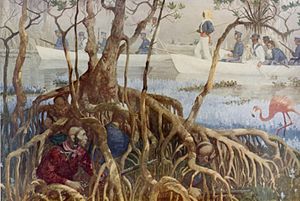Patriot War (Seminole Wars)
| Seminole Wars | |||||||
|---|---|---|---|---|---|---|---|
| Part of American Indian Wars | |||||||
 A U.S. Marine boat expedition searching the Everglades during the Second Seminole War |
|||||||
|
|||||||
| Belligerents | |||||||
|
|
Seminole Choctaw Freedmen |
||||||
| Commanders and leaders | |||||||
|
Martin Van Buren (1837-41) William Henry Harrison (1841) John Tyler (1841-42) Duncan Lamont Clinch Edmund P. Gaines, Winfield Scott (1836) Thomas Jesup (1836-38), Richard Gentry † (1837) David Moniac † (1836), Francis Langhorne Dade † (1835), Zachary Taylor (1838-40), Walker Keith Armistead (1840-41) William J. Worth (1841-42) Franklin Pierce (1856-57) James Buchanan (1857–1858) William S. Harney |
Alexander Arbuthnot † Robert Ambrister † Josiah Francis † Homathlemico † Osceola John Horse Billy Bowlegs |
||||||
| Strength | |||||||
| Peak: 40,000 Expeditionary: 8,000 | 1,500 | ||||||
| Casualties and losses | |||||||
| 1,500-2,000 | heavy | ||||||
Military stalemate
The Seminole Wars, also known as the Florida Wars, were three conflicts in Florida between the Seminole, a Native American tribe that formed in Florida in the early 18th century, and the United States Army. Taken together, the Seminole Wars were the longest and most expensive (both in human and monetary terms) of the Indian Wars in United States history.
The original indigenous peoples of Florida declined significantly in number after the arrival of European explorers in the early 1500s, mainly because the Native Americans had little resistance to diseases newly introduced from Europe. Spanish suppression of native revolts further reduced the population in northern Florida until the early 1600s, at which time the establishment of a series of Spanish missions improved relations and stabilized the population.
Raids from the newly- established English Province of Carolina beginning in the mid-1600s began another steep decline in the indigenous population. By 1707, English soldiers and their Yamasee Indian allies had killed, carried off, or driven away most of the remaining native inhabitants during a series of raids across the Florida panhandle and down the full length of the peninsula. In the first decade of the 18th century. 10,000 – 12,000 Indians were taken as slaves according to the governor of La Florida and by 1710, observers noted that north Florida was virtually depopulated. The Spanish missions all closed, as without natives, there was nothing for them to do. The few remaining natives fled west to Pensacola and beyond or east to the vicinity of St. Augustine. When Spain ceded Florida to Great Britain as part of the Treaty of Paris in 1763, the majority of surviving Florida Indians took passage with the Spanish to Cuba or New Spain.
...
Wikipedia
